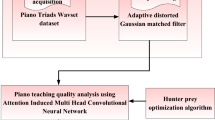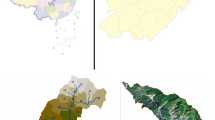Abstract
Intelligent recognition system is a new technology based on signal processing, artificial intelligence, cybernetics, computer technology, and other disciplines. The increase of greenhouse gas emissions accelerates global warming and water cycle and increases the frequency of extreme precipitation events. People’s personal safety has been threatened, and also it has brought huge property losses and also increased social unrest. In recent years, extreme rainfall events often occur in China, causing irreparable losses. As a result, the national government departments have paid great attention to extreme precipitation events, which has become one of the hot issues in the academic circles. Based on the advantages of convolution neural network algorithm in image processing, intelligent recognition system can realize many functions. Based on intelligent recognition technology, this paper evaluates the evolution characteristics of extreme rainfall weather and the later evaluation of music teaching. Through on-site detection, people can intelligently identify and demonstrate extreme rainfall weather. In today’s music classroom teaching, self-playing and singing is one of the core teaching skills of music teachers. To cultivate the independent performance ability and singing skills of music education major in university, not only the comprehensive music literacy of students will be improved, but also the practicability of students’ music learning will be increased, which will play a great role in the future music education work. In addition, the support of intelligent department system makes music education effect evaluation more efficient.











Similar content being viewed by others
Change history
17 November 2021
This article has been retracted. Please see the Retraction Notice for more detail: https://doi.org/10.1007/s12517-021-08982-4
28 September 2021
An Editorial Expression of Concern to this paper has been published: https://doi.org/10.1007/s12517-021-08471-8
References
Adeyeri OE, Laux P, Lawin AE, Arnault J (2020) Assessing the impact of human activities and rainfall variability on the river discharge of Komadugu-Yobe Basin, Lake Chad Area. Environ Earth Sci 79(6):1–12
Adnan S, Ullah K, Shuanglin L, Gao S, Khan AH, Mahmood R (2018) Comparison of various drought indices to monitor drought status in Pakistan. Clim Dyn 51(5-6):1885–1899
Bahrami M, Bazrkar S, Zarei AR (2019) Modeling, prediction and trend assessment of drought in Iran using standardized precipitation index. J Water Clim Chang 10(1):181–196
Beygi Heidarlou H, Banj Shafiei A, Erfanian M, Tayyebi A, Alijanpour A (2020) Land cover changes in Northern Zagros forests (Nw Iran) before and during implementation of energy policies. J Sustain For 40:1–15. https://doi.org/10.1080/10549811.2020.1747026
Cheng Q, Gao L, Zhong F, Zuo X, Ma M (2020) Spatiotemporal variations of drought in the Yunnan-Guizhou Plateau, southwest China, during 1960–2013 and their association with large-scale circulations and historical records. Ecol Indic 112:106041
Erdem O, Ceyhan E, Varli U (2014) A new correlation coefficient for bivariate time-series data. Phys A Stat Mech Appl 414:274–284
Huang S, Zheng X, Ma L, Wang H, Huang Q, Leng G, Meng E, Guo Y (2020) Quantitative contribution of climate change and human activities to vegetation cover variations based on GA-SVM model. J Hydrol 584:124687
Javadinejad S, Hannah D, Ostad-Ali-Askari K, Krause S, Zalewski M, Boogaard F (2019) The impact of future climate change and human activities on hydro-climatological drought, analysis and projections: using CMIP5 climate model simulations. Water Conserv Sci Eng 4(2-3):71–88
Jiang S, Wang M, Ren L, Xu CY, Yuan F, Liu Y, Lu Y, Shen H (2019) A framework for quantifying the impacts of climate change and human activities on hydrological drought in a semiarid basin of Northern China. Hydrol Process 33(7):1075–1088
Marini G, Fontana N, Mishra AK (2019) Investigating drought in Apulia region, Italy using SPI and RDI. Theor Appl Climatol 137(1-2):383–397
Marthews TR, Jones RG, Dadson SJ, Otto FE, Mitchell D, Guillod BP, Allen MR (2019) The impact of human-induced climate change on regional drought in the Horn of Africa. J Geophys Res-Atmos 124(8):4549–4566
Moghimi MM, Zarei AR, Mahmoudi MR (2019) Seasonal drought forecasting in arid regions, using different time series models and RDI index. J Water Clim Chang 11:633–654. https://doi.org/10.2166/wcc.2019.009
Musie M, Sen S, Chaubey I (2020) Hydrologic responses to climate variability and human activities in Lake Ziway Basin, Ethiopia. Water 12(1):164
Noor H (2017) Analysis of groundwater resources utilization and their current condition in Iran. J Rainwater Catchment Syst 5(2):29–38
Nyangena J, Onywere S, Shisanya C (2020) Evaluating the relationship between drought and vegetation greenness in Chyulu-Amboseli Rangeland, Kenya. J Appl Sci Environ Manag 24(1):65–71
Omer A, Zhuguo M, Zheng Z, Saleem F (2020) Natural and anthropogenic influences on the recent droughts in Yellow River Basin, China. Sci Total Environ 704:135428
Pakrooh P, Hayati B, Pishbahar E, Nematian J, Brännlund ER (2020) Focus on the provincial inequalities in energy consumption and CO2 emissions of Iran’s agriculture sector. Sci Total Environ 715:137029
Tsakiris G, Pangalou D, Vangelis H (2007) Regional drought assessment based on the reconnaissance drought index (RDI). Water Resour Manag 21(5):821–833
Ullah H, Akbar M, Khan F (2020) Construction of homogeneous climatic regions by combining cluster analysis and L-moment approach on the basis of reconnaissance drought index for Pakistan. Int J Climatol 40(1):324–341
Yousefi S, Mirzaee S, Zeini Vand H (2013) Investigation deforestation trends in Zagros mountain with using GIS and RS (case study: Marivan). J Appl RS GIS Tech Nat Resour Sci 4(2):15–22
Yu W, Zhang L, Zhang H, Jiang L, Zhang A, Pan T (2020) Effect of farmland expansion on drought over the past century in Songnen Plain, Northeast China. J Geogr Sci 30(3):439–454
Zare Feyz Abadi A, Kouchaki AR, Nasiri Mahalati M (2006) Trend analysis of yield, production and cultivated area of cereal in Iran during the last 50 years and prediction of future situation. Iran J Field Crops Res 4(1):49–69
Zarei AR (2018) Evaluation of drought condition in arid and semi-arid regions, using RDI index. Water Resour Manag 32(5):1689–1711
Funding
This work was supported by grants from the Scientific Research Program of Hubei Provincial Department of Education in 2018 (No. B2018557).
Author information
Authors and Affiliations
Corresponding author
Ethics declarations
Conflict of interest
The authors declare that they have no competing interests.
Additional information
Responsible editor: Sheldon Williamson
This article is part of the Topical Collection on Environment and Low Carbon Transportation
This article has been retracted. Please see the retraction notice for more detail:https://doi.org/10.1007/s12517-021-08982-4
About this article
Cite this article
He, D., Luo, N. RETRACTED ARTICLE: Spatiotemporal evolution characteristics of extreme rainfall based on intelligent recognition and evaluation of music teaching effect in colleges and universities. Arab J Geosci 14, 1571 (2021). https://doi.org/10.1007/s12517-021-07929-z
Received:
Accepted:
Published:
DOI: https://doi.org/10.1007/s12517-021-07929-z




